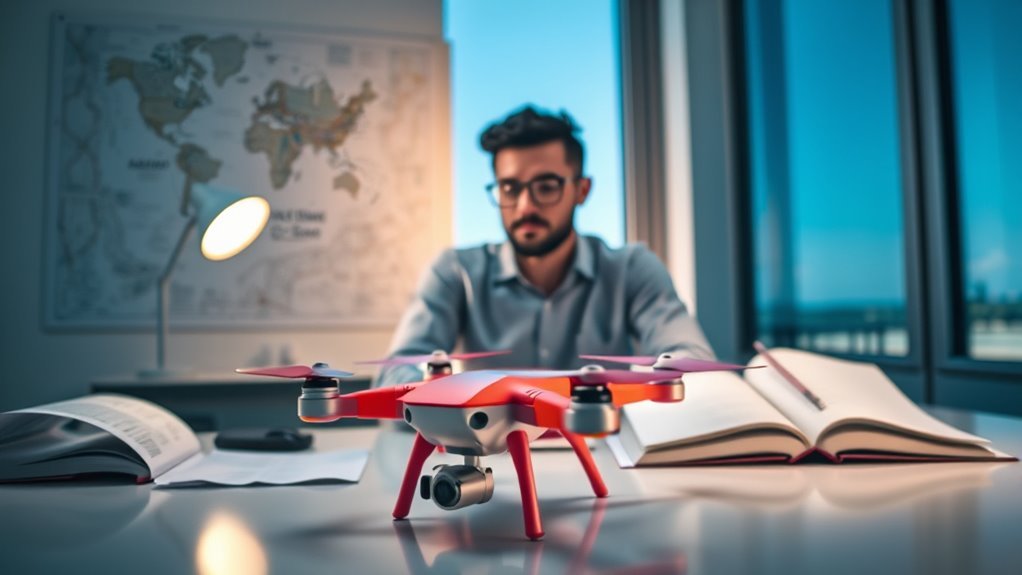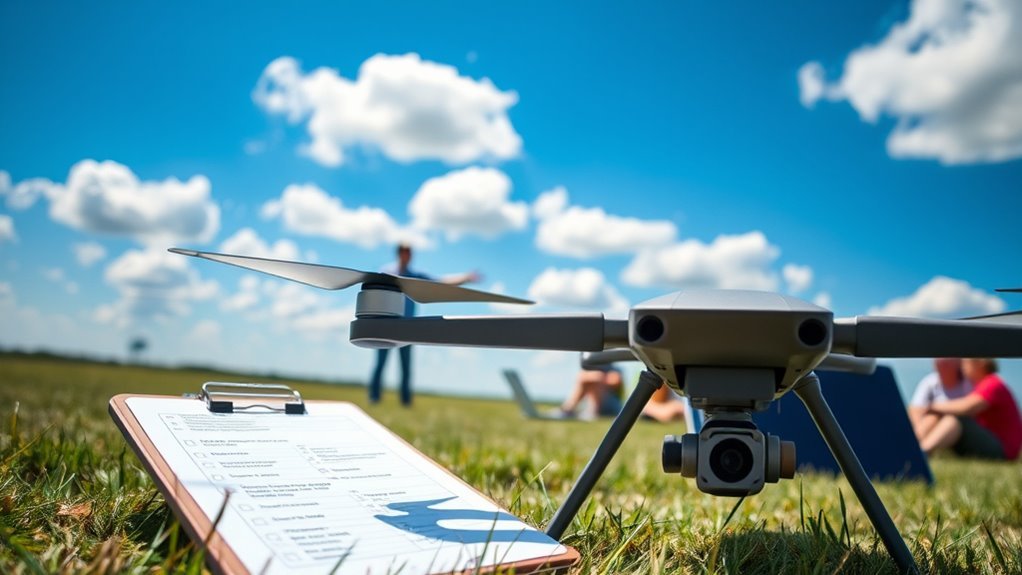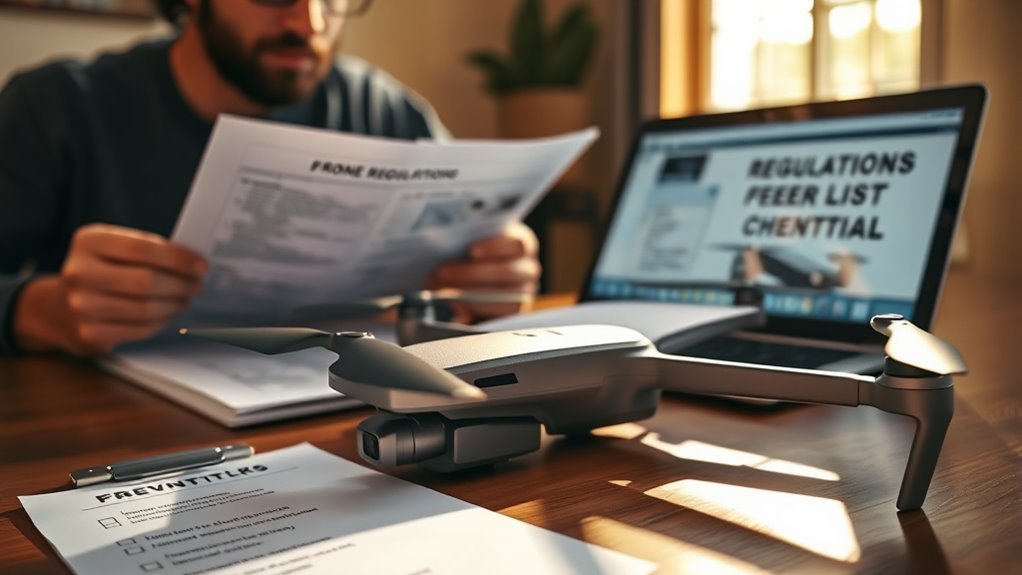To get your drone pilot license, you need to follow these essential steps: First, understand the regulations and requirements set by the FAA. Next, choose the right drone for your needs. Complete a ground school course to build your knowledge. Accumulate flight experience by logging hours in different conditions. Then, pass the FAA written exam and schedule your practical flight test. Finally, keep your license current and stay updated on regulations for safe flying. There’s more to explore on this journey.
Understand the Regulations and Requirements

Before you take to the skies, it’s essential to understand the regulations and requirements surrounding drone piloting. Staying informed about regulatory updates is vital, as rules can change frequently. Familiarize yourself with the Federal Aviation Administration (FAA) guidelines, which govern airspace, flight restrictions, and safety protocols. To guarantee compliance, consider these tips: always register your drone, complete the necessary training, and pass the knowledge test to obtain your pilot license. Additionally, keep abreast of any local regulations that may apply in your area. By prioritizing compliance, you not only enhance your flying experience but also contribute to safer skies for everyone. Embrace your freedom, but remember that knowledge is your best ally in the world of drone piloting.
Choose the Right Drone for Your Needs

When choosing the right drone, it’s vital to take into account your specific purpose for use, whether it’s for photography, surveying, or recreational flying. Budget also plays an important role, as drones can range greatly in price based on features and capabilities. By pinpointing your needs and financial limits, you’ll make a more informed decision on the best drone for you. For instance, beginner-friendly drones like the DJI Mini SE and Holy Stone HS175 are excellent choices for those just starting out. Additionally, understanding camera quality is essential for selecting a drone that meets your photography or videography needs.
Purpose of Drone Use
Choosing the right drone starts with understanding your specific needs and purposes. If you’re interested in recreational use, you might prioritize features like ease of control and camera quality for capturing stunning aerial shots. These drones are often lightweight and user-friendly, making them perfect for hobbyists. On the other hand, if you’re considering commercial applications, you’ll want to focus on drones that offer advanced capabilities like higher payloads, longer flight times, and superior imaging technology. Think about what you aim to achieve—be it photography, surveying, or inspections. Tailoring your choice to your intended use guarantees you get the most out of your drone experience, empowering you to explore and maximize your creativity in the skies.
Budget Considerations
Understanding your specific needs and purposes not only helps in selecting the right drone but also plays a significant role in budgeting. When you’re choosing a drone, consider both the initial purchase price and ongoing expenses. Higher-end models may offer advanced features, but they come with higher licensing fees and training costs that could strain your budget. Think about what you’ll be using the drone for—hobbyist flying might require less investment than commercial use. Additionally, factor in maintenance and accessories that might be needed. By aligning your drone choice with your budget and requirements, you’ll guarantee that you’re not just flying high, but also spending wisely. Freedom in the sky starts with a smart financial plan!
Complete a Ground School Course

Before you can take to the skies, you’ll need to complete a ground school course that covers essential topics like airspace regulations, drone operations, and safety protocols. This training not only prepares you for the flying part but also helps you meet certification requirements set by aviation authorities. Understanding the course content is vital for your success as a drone pilot.
Course Content Overview
Initiating the journey to obtain your drone pilot license starts with a solid foundation in aviation knowledge, which is where a ground school course comes into play. These courses cover essential course objectives, ensuring you’re well-prepared for safe and responsible flying. You’ll plunge into topics like airspace classifications, weather patterns, and regulations specific to drone operations.
The learning materials will often include textbooks, videos, and interactive simulations, making it easier to grasp complex concepts. Engaging with instructors and fellow students will further enhance your understanding. By fully embracing this curriculum, you’ll gain the confidence and skills necessary to operate your drone freely and effectively, setting the stage for a successful piloting experience.
Certification Requirements Explained
While pursuing your drone pilot license, completing a ground school course is an essential step that lays the groundwork for your certification. These training programs offer thorough knowledge about airspace regulations, flight operations, and safety protocols, ensuring you’re well-prepared for the challenges of flying a drone. You’ll learn about the licensing procedures required by the FAA, which are vital to legally operate your drone. Additionally, ground school provides valuable insights into weather conditions, navigation, and aircraft systems, allowing you to make informed decisions. By engaging in this structured learning, you’ll not only gain confidence but also enhance your ability to fly freely and safely. Completing a ground school course is a pivotal part of your journey towards becoming a certified drone pilot.
Accumulate Flight Experience
To become a skilled drone pilot, you need to accumulate flight experience that sharpens your skills and builds your confidence. Start by logging flight hours in varied conditions to enhance your adaptability. Utilize diverse training techniques, such as flying in different weather scenarios or practicing complex maneuvers. Each flight is an opportunity to refine your control, understand your drone’s capabilities, and prepare for real-world applications. Consider joining local flying clubs or participating in community events to gain insights from experienced pilots and expand your network. Remember, consistency is key; the more you fly, the more intuitive your piloting skills will become. Embrace this journey, and you’ll not only gain experience but also the freedom that comes with being a competent drone pilot. Additionally, engaging in hands-on training can further solidify your flight skills through practical experience. A great starting point for beginners is the DJI Mini SE, which offers user-friendly features and impressive flight time.
Pass the FAA Written Exam
Once you’ve built a solid foundation of flight experience, the next step is to pass the FAA written exam. This exam tests your understanding of aviation concepts, regulations, and safety procedures. To succeed, develop effective written exam strategies. Start by gathering reliable study materials, such as FAA handbooks, online courses, and practice tests. These resources will help you grasp vital topics like airspace classifications, weather patterns, and drone operations. Create a study plan, focusing on one topic at a time, and use practice questions to assess your knowledge. Don’t forget to join study groups or forums; sharing insights with fellow pilots can enhance your preparation. With dedication and the right approach, you’ll be on your way to earning your drone pilot license.
Schedule and Pass the Practical Flight Test
After successfully passing the FAA written exam, the next crucial step is scheduling and passing the practical flight test. This hands-on assessment is your chance to showcase your piloting skills. First, find a certified instructor or training facility; they can offer practical tips to help you prepare. Focus on mastering essential flight maneuvers, such as takeoffs, landings, and emergency procedures. During the test, stay calm and confident—demonstrating your ability to handle various scenarios is key. Remember to familiarize yourself with the drone you’ll be flying, as different models can have unique controls. Ultimately, practice regularly and seek feedback to refine your skills. Your goal is to prove you can operate safely and effectively in the skies.
Maintain Your License and Stay Updated
Maintaining your drone pilot license requires ongoing commitment, as regulations and technology are constantly evolving. To keep your freedom in the skies, you’ll need to stay informed about changes in aviation laws and best practices. Scheduling your license renewal on time to avoid any lapses in your certification is essential. Participating in ongoing education opportunities, like workshops or online courses, not only sharpens your skills but also enhances your understanding of new equipment and software advancements. For instance, learning about advanced obstacle avoidance can significantly improve your flying safety. Engage with fellow pilots through forums or local clubs to share experiences and insights. By staying proactive, you guarantee your flying remains legal and safe, allowing you to fully enjoy the exhilarating world of drone piloting without any restrictions. Your journey doesn’t end with certification; it’s just the beginning! Utilizing proactive vulnerability identification can also help improve your overall safety and security while operating your drone.
Frequently Asked Questions
How Much Does It Cost to Obtain a Drone Pilot License?
Obtaining a drone pilot license can vary widely in cost. You’ll need to evaluate the cost breakdown of training, testing, and potential hidden fees for materials or equipment. It’s best to budget carefully to avoid surprises.
Can I Use a Foreign Drone for My Certification?
Did you know nearly 70% of drone enthusiasts face foreign drone regulations? You can use a foreign drone for certification, but make certain it meets your local certification requirements to avoid potential legal hurdles.
Are There Age Restrictions for Becoming a Drone Pilot?
Yes, there are age requirements for becoming a drone pilot. Most drone regulations require you to be at least 16 years old. So, if you’re enthusiastic to fly, make sure you meet this requirement!
How Often Do I Need to Renew My Drone Pilot License?
You’ll need to renew your drone pilot license every two years. This renewal process guarantees your skills stay sharp and your license validity remains intact, allowing you to enjoy the freedom of flying without worries.
Can I Fly My Drone at Night With a License?
Yes, you can fly your drone at night with a license, but you must follow night flying regulations. Make certain your drone is equipped for nighttime operations, and always maintain visual line of sight while flying.

